- Home
- Anthony Bourdain
Typhoid Mary
Typhoid Mary Read online
Typhoid Mary
Bourdain, Anthony
Bloomsbury Publishing Plc (2001)
Rating: ★★★☆☆
* * *
* * *
### Review
'What Jean Genet was to the prison, what Tom Waits is to the lowlife bar, Bourdain is to the restaurant kitchen: a charmingly roguish guide to a tough, grimy underworld with its own particular rules and rituals ... a tale of hot pursuit, with the rude gusto and barbed wit that made Kitchen Confidential such a full-bodied pleasure' New York Times Book Review 'Raw, readable prose' Entertainment Weekly 'Bourdain's prose is utterly riveting' New York Magazine 'A juicy drama ... Bourdain creates a varied historical portrait of Mallon's time' Seattle Times
### Product Description
In 1906, at a prosperous Long Island summer home, a family falls ill and typhoid is diagnosed. When Dr George Soper is called in to find the source of the contagion, he notices that the household cook has gone missing. She is Mary Mallon, the woman who would become known as Typhoid Mary. Soper, sanitary engineer turned sleuth, sees Mary as his Moriarty. He finds there has been an outbreak of typhoid fever in every household she has worked in over the past decade. Mary is a 'carrier', a seemingly healthy individual who passes on her dangerous germs, sometimes with fatal consequences. Now Soper must hunt the cook down before she can infect more unsuspecting victims. A poor Irish immigrant, Mary refuses to believe that she can harbour typhoid in her strong and healthy body, and she doesn't intend to go quietly. In this fascinating true story Bourdain, in an homage from one cook to another, follows Mary through the kitchens of New York, putting a human face to a desperate and unintentional murderer, and examines a time, and a life, with his inimitable style.
TYPHOID MARY
Anthony Bourdain
The True Story
of
What May or May Not Have Been the Greatest Hoax
Ever Played on the Citizens of Gotham
to Nancy
‘God sends us meat –
but the devil sends us cooks.’
– Julius Chambers from The Book of New York
quoting an unnamed ‘grouchy Englishman’
Author’s Prologue
Sick
Historically, to be a cook, to prepare food for others, was always to identify oneself with the degraded and the debauched. As far back as ancient Rome, and as recently as pre-Civil War America, cooks were slaves. Untrustworthy, unpleasant, and more often than not, unhealthy, cooks in early twentieth-century Europe and America worked in hot, unventilated spaces for long hours. They were underpaid, underfed, and underappreciated – their cruel masters despotic, megalomaniacal tyrants, parsimonious desk-jockeys, and brutish warders. Cooks tended – as they still do – to drink. And they died, usually at a young age, with their livers bloated by booze, their feet flattened, hands gnarled, faces ravaged, their lungs coated with the sediment of years of inhaling smoke, airborne grease, and bad air. Their brains were fried by the heat and the pressure and the difficulty of suppressing mammoth surges of rage and frustration, their nervous systems frazzled by mood swings which peaked and crashed with each incoming rush of business. They sweated and toiled in obscurity, cursed their customers, one another, their underlings, and their evil overlords. They cursed the world outside their kitchen doors for making them work like animals, for making them bend always to another’s will. For existing.
And yet they were almost always proud. Cooks knew then, as they know now, that the people ‘out there,’ – the ones who lived outside those swinging kitchen doors, the ones who owned homes, who went out to dinner or to the theater on weekend nights, the ones who had holidays off and who saw their loved ones for more than a few fleeting hours a week, were different. Civilians, as all cooks know, take their pleasures in different ways and, just as significantly, at different times. The rules they live by are different too. And just as cooks are not understood, they don’t, can’t, and never have understood ‘them’. The world of the nine-to-five worker, the property owner, the regular restaurant goer, the boss, is completely and maddeningly incomprehensible to those who’ve spent most of their lives bent over a hot range. As author Michael Ruhlman points out, cooks don’t understand how others can live the way they live out there, in all that sloppy, unregimented luxury. It’s messy. It’s wasteful. It’s scary and disorganized. Out there, things just don’t seem to work the way they should.
For a cook, the well-ordered safety and certainty of the kitchen, however hot, cramped, and occasionally crazed, is a place of absolutes. The chef is the Absolute Leader. Food is always served on time. Cold food is served cold. Hot food is served hot. No one is late. No one calls in sick.
Let me repeat that: No one calls in sick.
The world outside the kitchen doors, to the mind of the cook, is imperfect – a constant source of disappointment, a place of thousands of tiny betrayals which threatens at all times to intrude into their own territory. Cooks are territorial creatures. No Serbian militia or feral dog defends its terrain more fiercely, and seemingly unreasonably, than a cook protects his station. Mis-en-place, the general sense of things being the way they should be – of being ready for anything – extends only to the exit. Outside, it’s a strange and terrible place where things happen and don’t happen in unpredictable and unforeseeable ways.
Mary Mallon, the woman who came (to her everlasting displeasure) to be known as Typhoid Mary, was a cook. Much has been written about Ms. Mallon over the years. There have been sensational newspaper accounts, plays, works of fiction, the predictable feminist reevaluations depicting her as the sad victim of an unfeeling, racist, sexist society bent on bringing a good woman down – her persecution and incarceration the result of some gender-insensitive Neanderthals looking for a quick fix to an embarrassing public health problem. And there is an element of truth in almost all these characterizations. She was a woman. She was Irish. She was poor. None of these, listed on a resume in 1906, was going to put you on the fast track to the White House or a corporate boardroom or even a box seat at the opera.
Because, first and foremost, Mary Mallon was a cook. And her story, first and foremost, is the story of a cook. While that may not explain everything about some of the troubling aspects of her life, it explains a hell of a lot. Her tale has not yet, to my knowledge, been told from that point of view.
Little historical record of Mary’s life can be depended on – and there are few recorded words or utterances from her own mouth. The accounts of the time, from others involved, directly or indirectly, with her case, are all too often self-serving, incomplete, sensationalistic, or plain wrong. Few, if any, take into account the worldview of the career cook.
There is one excellent, scrupulously researched, comprehensive and insightful telling of Mary’s story: Judith Walzer Leavitt’s Typhoid Mary: Captive to the Public’s Health, an absolutely indispensable volume which should (and did, in my case) serve as a road map to anyone interested in her life and times. But Leavitt’s work focuses largely on the troubling public health and civil liberties issues raised by Mary’s incarceration by health authorities, drawing a meaningful comparison to today’s AIDS crisis, and the moral quagmire officials encounter when confronted with otherwise blameless people who can, through casual contact with others, cause illness or death.
That’s not where I’m going here. I’m a chef, and what interests me is the story of a proud cook – a reasonably capable one by all accounts – who at the outset, at least, found herself utterly screwed by forces she neither understood nor had the ability to control. I’m interested in a tormented loner, a woman in a male world, in hostile territory, frequently on the run. And I’m interested in denial – the ways that Mary, and many of us, find to avoid the obviou
s, the lies we tell ourselves to get through the day, the things we do and say so that we can go on, drag our aching carcasses out of bed each day, climb into our clothes and once again set out for work, often in kitchens where the smell, the surroundings, the ruling regime oppress us.
Going in, I knew only that she was a cook with a problem. Few, it seemed, knew her real name. ‘Typhoid Mary’, the moniker she’s come to be remembered by, is now an all-purpose pejorative, an epithet implying evil intent, willful contagion; shorthand for a woman so foul, so unpleasant, so infectious as to destroy all she touches. If you were to ask a passerby who Typhoid Mary was, you might hear that she was a plague carrier, someone responsible for infecting and killing thousands.
In fact, as I soon discovered, Mary’s total body count – for all her career – as tabulated by her most fervent and least forgiving pursuer – came to thirty-three persons infected, with confirmed deaths of only three. Although, in all likelihood, there probably were a few more uncounted, undiscovered cases associated with Mary. God bless her, she often worked off the books.
So knowing nothing when I began this project, I soon found myself rooting around dusty collections, library stacks and archives. Research was fun, I have to say. I’ve been penned up in various versions of a 25-foot by 10-foot professional kitchen (like Mary) for most of my adult life, so it was a very new experience for me to acquire knowledge in silence, seated. It helped that I was writing about a fellow cook.
The history of my profession has always fascinated me. Years ago, at culinary school, my fellow students and I loved the stories of Vatel, for instance, impaling himself on his sword over a late fish delivery. While we admired the seriousness with which he took his enterprise, we also thought, ‘What a punk! Who hadda cover for him the next day at work?!’ Carême’s edible monuments and minarets, his kooky ambition to marry architecture, fine art, and the preparation of food inspired generations of cooks to all sorts of terrible and ludicrous excesses, nearly drove some insane trying to emulate his maniacal construction projects. We have – all of us professionals – worshipped at the altar of Escoffier, memorized his recipes, been drilled in his methods, heard and cherished stories of the Great Man, burned his image and the names of his dishes into our brains as deeply as any disciples of Chairman Mao or L. Ron Hubbard. We know the names of the greats like divinity students know the names of the apostles: Point, Troisgros, Bocuse, Guerard, Robuchon, and so on . . . We know their progeny, the ones who came after – who begot whom – and in which kitchens – and we are comforted by knowing the names. It puts our own lives, our own toil, in perspective – it reminds us that we are a part of something, cogs, however tiny, in a great machine whose wheels have been turning for centuries. One of the best parts of being a chef or a cook is exactly that sense of belonging to something, of being made members of a large and secret society. It feels good knowing you are part of a long and glorious tradition of suffering, insanity, and excess. We may not have a secret handshake (though even brushing contact with the callused hand of another cook communicates, in an instant, scads of information) but we have a language, customs, tribal rituals all our own. There is a common structure, a shared understanding of the world, a hierarchy, terminology, and initiation with which we are all – whether flipping burgers in a Bora Bora beach bar or spooning caviar at the top of the World Trade Center – intimately familiar, and we take comfort in that too.
It has been until all too recently, however, a predominantly male club, this thing of ours. In exactly the reverse of the ignorant dictum that ‘Women Should Stay In The Kitchen – Preferably While Barefoot and Pregnant’, in the hotel/restaurant kitchen it was always, ‘They’re not strong enough to lift heavy stockpots!’ (Hilariously wrong in that NO cook I’ve ever seen hoisted full stockpots without assistance – okay, one guy. We called him Hernia Boy.) Women, it was said, ‘Can’t take the pressure!’ they’re ‘Too emotional!’ You want to see emotional? Watch a table of ten’s order come back for a refire in a busy all-male kitchen in the middle of the rush. You’ve never seen such weeping and rending of garments and tantrum throwing since you smacked your little brother and took away his favorite stuffed toy.
Point is, in the annals of professional cooking, there are precious few names of women. Catherine de Medici comes to mind, but she didn’t cook. She was, however, smart enough to bring along some Italian cooks when she moved to France. Had she not, the French might still be thickening their sauces with bread raspings – and tearing at their food with daggers and bare hands.
Not that women weren’t cooking professionally. There were, all along, at any given moment, probably more women cooking than men. It’s just that they were doing it in private homes, tiny bistros, Parisian pork stores, institutions. They stayed closer to the traditional role of professional cook of Roman times – which is to say they were slaves. Or darn close. They cooked, most times, alone. The domestic cooks of the nineteenth century and early twentieth didn’t often work as part of a crew (a tendency tragically mirrored today with the predominance of the female pâtissier in the otherwise all-male kitchen). They didn’t get to enjoy the yo-ho-ho camaraderie, the grab-ass hijinks of the restaurant kitchen. They did not enjoy the aid and company of sauciers, grillardins, entremetiers, poissoniers, garde-mangers, and plongeurs to assist them in their work. There were rarely chefs or sous-chefs to stand between them and their masters, no one to protect them from the caprices and unreasonable desires of their clients.
If Mary was part of anything, she was part of a very different movement, one forged in hunger, dislocation and social upheaval, a sea-change which pushed millions of women out of their homeland and away from their traditional roles, across the sea and into the lonely business of domestic servitude.
I have known, at various low points in my long and checkered career, what it feels like when one’s pride in what one does – one’s love of cooking, one’s faith in one’s ability – begins to fade, and I know the kind of sloppiness that can follow. Fortunately, in my case, those days are long gone. I got a second chance. Mary never did.
Bouncing from job to job, with lousy pay, no health insurance, no sick days, no vacation, miss one day at work and it’s back on the treadmill . . . find another dirty, badly equipped kitchen . . . and no hope in the world. You endure simply so that you can afford to go on enduring. The small, simple joys of a perfectly made bowl of soup, a rustic stew, a lovely piece of fish cooked just right, disappear, replaced over time by a simmering forced-down resentment, bubbling up and choked down again and again like burning reflux. The small annoyances grow large: the way the boss smacks his wet lips when he tastes the soup, the acrid cloud from the steam table, the smell of old grease, the lingering odor of lamb fat – these become the nexus of all the evils and injustices of the world.
That you may have cooked good food in the past, worked in the homes of the rich, in great houses or great kitchens, seen the pyramids or danced naked on the moon, matters not at all. Nobody cares.
Where once you would have turned your head to cough, you turn no longer. Wash your hands after going to the bathroom? Maybe. If you have time, you’re beyond caring. The people eating your food are abstractions now. Cough or no cough, you know they’ll be back tomorrow, maybe for the Early Bird, the All-You-Can-Eat special. Unwashed hands, an errant cigarette ash, a roasted chicken dropped on a dirty kitchen floor and retrieved on the bounce . . . we’ve been there, you and me and Mary.
The central question when examining the career of Mary Mallon, cook, is always, ‘Why did she go on cooking when she had every reason to believe she was spreading a possibly fatal disease?’ Many of you who’ve worked in greasy spoons, coffee shops, cafeterias, failing, not-very-good restaurants, institutional food services, know the answer already. I won’t blame you if you don’t care to admit it. But you know what the ‘three-second rule’ is. Don’t you?
Cooks work sick. They always have. Most jobs, you don’t work, you don’t get paid. You wake up wit
h a sniffle and a runny nose, a sore throat? You soldier on. You put in your hours. You wrap a towel around your neck and you do your best to get through. It’s a point of pride, working through pain and illness. And in the paranoid realpolitik world of the kitchen it makes a great deal of sense. If you don’t show up to work, someone else fills in for you – either an already overburdened fellow cook, who takes on additional tasks – or worse, an outsider, an interloper, a stranger who might well be considered to do a better job than you – or be less likely to call in sick in the future. When you are working in a kitchen that serves something less than haute cuisine, the likelihood increases that a strong back and the ability to endure are of the utmost importance, a chef or owner frequently passing over the superior technician for the more reliable one.
Mary, it should be pointed out, felt fine. She was strong. She was tough. She could take it – and she was proud of her endurance. She worked, and she went on – and when after a time they told her to stop, she ignored them and went on working. One finds oneself being defined by one’s job. The job expiates us from sin; it excuses us our excesses and our lapses. That we are tired, or ill, or in extremis and yet persevere is all we have, sometimes, to sustain our image of ourselves.
Like Mary, I’ve worked for private clients. Briefly. Had I stayed on, had my boss asked me one more time for ‘an egg-white omelette – and no butter or oil in the pan,’ I would surely have grabbed hold of his skull, squeezed until his eyeballs popped out of his head like pachinko balls. Had I worked in the homes of the rich and silly circa 1906? I would have murdered them in their beds with the nearest available blunt object. I was never tough enough to put up with what Mary put up with. I’m ‘too emotional’; I couldn’t have ‘taken the pressure’; I doubt very much I could have picked up heavy stockpots alone.

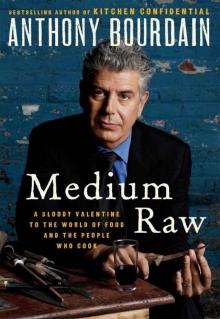 Medium Raw: A Bloody Valentine to the World of Food and the People Who Cook
Medium Raw: A Bloody Valentine to the World of Food and the People Who Cook The Bobby Gold Stories
The Bobby Gold Stories Gone Bamboo
Gone Bamboo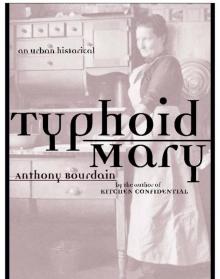 Typhoid Mary
Typhoid Mary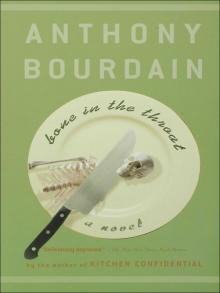 Bone in the Throat
Bone in the Throat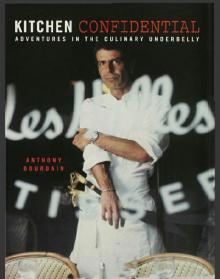 Kitchen Confidential
Kitchen Confidential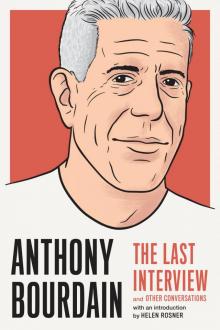 Anthony Bourdain: The Last Interview
Anthony Bourdain: The Last Interview Bobby Gold Stories
Bobby Gold Stories